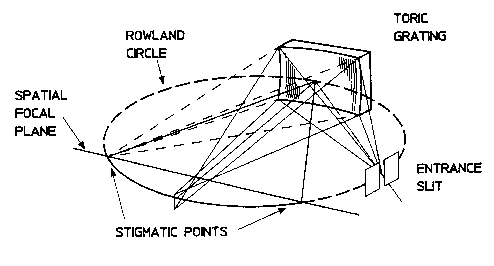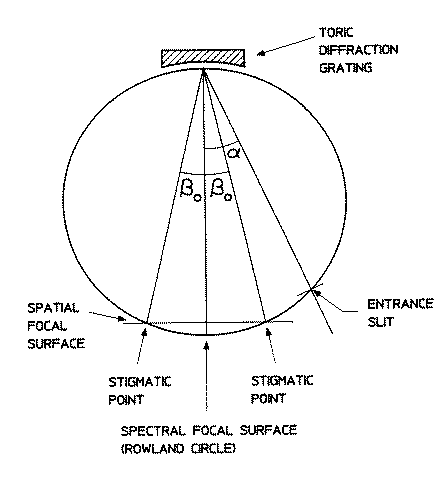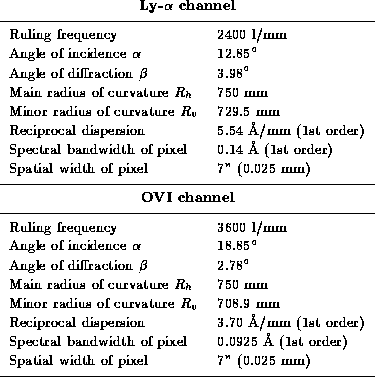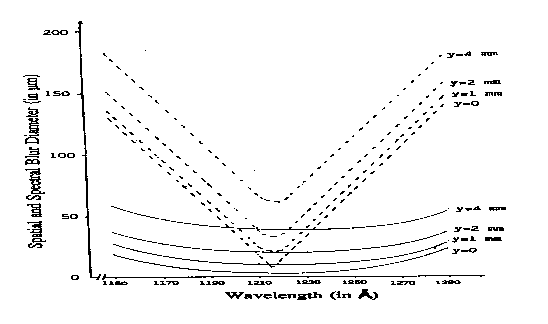


Next: Diffraction Gratings
Up: The Spectrometer Assembly
Previous: The Spectrometer Assembly
The UVCS spectrometer assembly has been designed to cover a suitable spectral
range according to the scientific requirements. For several reasons, e.g.,
reflectivity of the optical coatings, large differences in the emitted
intensity among the elements of the solar corona and others, it has been
designed to accomodate two very similar UV channels. One is
optimized at 1216 Å for the observations of the HI Ly- line and a
second one at 1035 Å for the OVI lines at 1032 Å and 1037 Å.
Their optical design has also been driven by mechanical
constraints on the accommodation of the main optical elements: entrance
slits, gratings and detectors. Both spectrometer channels use toric gratings and thus assure stigmatic spectral imaging: a single, albeit aspheric optical surface provides diffraction, reflection and focusing, as well as correction for astigmatism. Given the relatively low reflection coefficients in the vacuum ultraviolet wavelength domain, a single optical surface is optimum with respect to efficiency.
Each UVCS grating is used in a Rowland-circle mounting, with a diffraction angle,
line and a
second one at 1035 Å for the OVI lines at 1032 Å and 1037 Å.
Their optical design has also been driven by mechanical
constraints on the accommodation of the main optical elements: entrance
slits, gratings and detectors. Both spectrometer channels use toric gratings and thus assure stigmatic spectral imaging: a single, albeit aspheric optical surface provides diffraction, reflection and focusing, as well as correction for astigmatism. Given the relatively low reflection coefficients in the vacuum ultraviolet wavelength domain, a single optical surface is optimum with respect to efficiency.
Each UVCS grating is used in a Rowland-circle mounting, with a diffraction angle,  , near the grating normal. The horizontal (i.e., spectral) focus of a spherical concave grating lies on the Rowland circle, and the vertical (i.e. spatial) focus lies outside this circle. The Rowland circle has a diameter equal to the horizontal radius of curvature, R
, near the grating normal. The horizontal (i.e., spectral) focus of a spherical concave grating lies on the Rowland circle, and the vertical (i.e. spatial) focus lies outside this circle. The Rowland circle has a diameter equal to the horizontal radius of curvature, R , of the grating surface. When an originally spherical grating surface is transformed into a toric one by making the vertical radius of curvature, R
, of the grating surface. When an originally spherical grating surface is transformed into a toric one by making the vertical radius of curvature, R , smaller than R
, smaller than R , then the vertical (i.e. the stigmatic) focal plane begins to approach the Rowland circle. Eventually, the two focal surfaces touch at
, then the vertical (i.e. the stigmatic) focal plane begins to approach the Rowland circle. Eventually, the two focal surfaces touch at  and then intersect each other at
and then intersect each other at  =
=  . Both, astigmatism correction and spectral focus occur at the so-called stigmatic points, i.e. where the stigmatic focusing-surface intersects (or touches) the Rowland circle (see Figure 8
. Both, astigmatism correction and spectral focus occur at the so-called stigmatic points, i.e. where the stigmatic focusing-surface intersects (or touches) the Rowland circle (see Figure 8  ). The relation between vertical and horizontal radii of curvature of the grating surface, the angle of incidence,
). The relation between vertical and horizontal radii of curvature of the grating surface, the angle of incidence,  , and the angles of diffraction,
, and the angles of diffraction,  , where the astigmatism is corrected, is (see Figure 9
, where the astigmatism is corrected, is (see Figure 9  )
)


Figure 8: Isometric display of the imaging properties between the two stigmatic points  .
.

Figure 9: Schematic of the spectral and spatial imaging of a single toric grating. Exact stigmatic focusing is obtained at angles of diffraction  , which are defined by Equation 5. Given a sufficiently small value of
, which are defined by Equation 5. Given a sufficiently small value of  , effective stigmatic focusing (with respect to the pixel size)can be achieved between and somewhat beyond the two stigmatic points.
, effective stigmatic focusing (with respect to the pixel size)can be achieved between and somewhat beyond the two stigmatic points.
In the vicinity of the astigmatic foci, i.e., near the angles of diffraction,  , the separation of the spectral and spatial foci along a bundle of light rays is small. Here, the blur remains near the detector resolution and effective stigmatic imaging occurs. As long as
, the separation of the spectral and spatial foci along a bundle of light rays is small. Here, the blur remains near the detector resolution and effective stigmatic imaging occurs. As long as  is kept small, effective stigmatic imaging can be maintained on both sides of the grating normal over a section of the Rowland circle that slightly exceeds
is kept small, effective stigmatic imaging can be maintained on both sides of the grating normal over a section of the Rowland circle that slightly exceeds 
 . In
order to reduce the aberrations, it was necessary to keep the angle of
incidence
. In
order to reduce the aberrations, it was necessary to keep the angle of
incidence  on the gratings small and the diffraction angle
on the gratings small and the diffraction angle  as
near as possible to zero. The parameters of the optical design are summarized
in Table II.
as
near as possible to zero. The parameters of the optical design are summarized
in Table II.
Table II: Optical parameters of the UVCS spectrometer channels.

In order to scan a suitable spectral range through the FOV of the
detector, both the gratings can rotate, being mounted in a Johnson (1952)-Onaka (1958)
configuration. The best center of rotation of the grating is located at
127 mm from its vertex along a direction nearly perpendicular to the bisector
line of the angle between the incident and the diffracted rays. In this way,
the grating translates when rotating, always keeping the best spectral focus
on the detector. In the OVI channel, a grazing incidence mirror has been
mounted (not shown in Figure 9  ) in order to deviate and focus the Ly-
) in order to deviate and focus the Ly- line radiation on the detector.
In this way redundancy is provided
for the Ly-
line radiation on the detector.
In this way redundancy is provided
for the Ly- observations.
observations.
A preliminary evaluation of the optical performances of the spectrometer has
been done through extensive ray-tracings for both the Ly- and the OVI
channels. In Figure 10
and the OVI
channels. In Figure 10  some ray-tracing results for the Ly-
some ray-tracing results for the Ly- channel are reported as examples. The
spectral and spatial blurs vs. wavelength for various positions of a point
source with respect to the dispersion plane are shown.
channel are reported as examples. The
spectral and spatial blurs vs. wavelength for various positions of a point
source with respect to the dispersion plane are shown.
From the analysis of these ray-tracings, the following conclusions can be
derived regarding the predicted optical performance:
- For point sources near the middle (~1mm) of the entrance slit,
the expected spectral aberrations are considerably smaller than the pixel size (25
 m);
m);
- The same is true for the spatial aberrations near the stigmatic points,
i.e. Ly-
 and OVI lines; obviously, they increase for wavelengths far
from the stigmatic points;
and OVI lines; obviously, they increase for wavelengths far
from the stigmatic points;
- For points far from the middle of the entrance slit, both the
spectral and spatial aberrations increase because of defocusing; the former
is greater than 2 pixels for the extreme points;
- All the aberrations are proportional to the illuminated portion of the
grating.

Figure 10: Predicted spectral (solid) and spatial (dashed) blurs of the Ly- channel. Several curves for point sources at indicated distances (y) from 0 to 4mm from the middle of the entrance slit are provided.
channel. Several curves for point sources at indicated distances (y) from 0 to 4mm from the middle of the entrance slit are provided.



Next: Diffraction Gratings
Up: The Spectrometer Assembly
Previous: The Spectrometer Assembly
Raid Suleiman
Thu Apr 11 09:35:42 EDT 1996
 line and a
second one at 1035 Å for the OVI lines at 1032 Å and 1037 Å.
Their optical design has also been driven by mechanical
constraints on the accommodation of the main optical elements: entrance
slits, gratings and detectors. Both spectrometer channels use toric gratings and thus assure stigmatic spectral imaging: a single, albeit aspheric optical surface provides diffraction, reflection and focusing, as well as correction for astigmatism. Given the relatively low reflection coefficients in the vacuum ultraviolet wavelength domain, a single optical surface is optimum with respect to efficiency.
Each UVCS grating is used in a Rowland-circle mounting, with a diffraction angle,
line and a
second one at 1035 Å for the OVI lines at 1032 Å and 1037 Å.
Their optical design has also been driven by mechanical
constraints on the accommodation of the main optical elements: entrance
slits, gratings and detectors. Both spectrometer channels use toric gratings and thus assure stigmatic spectral imaging: a single, albeit aspheric optical surface provides diffraction, reflection and focusing, as well as correction for astigmatism. Given the relatively low reflection coefficients in the vacuum ultraviolet wavelength domain, a single optical surface is optimum with respect to efficiency.
Each UVCS grating is used in a Rowland-circle mounting, with a diffraction angle,  , near the grating normal. The horizontal (i.e., spectral) focus of a spherical concave grating lies on the Rowland circle, and the vertical (i.e. spatial) focus lies outside this circle. The Rowland circle has a diameter equal to the horizontal radius of curvature, R
, near the grating normal. The horizontal (i.e., spectral) focus of a spherical concave grating lies on the Rowland circle, and the vertical (i.e. spatial) focus lies outside this circle. The Rowland circle has a diameter equal to the horizontal radius of curvature, R , of the grating surface. When an originally spherical grating surface is transformed into a toric one by making the vertical radius of curvature, R
, of the grating surface. When an originally spherical grating surface is transformed into a toric one by making the vertical radius of curvature, R , smaller than R
, smaller than R , then the vertical (i.e. the stigmatic) focal plane begins to approach the Rowland circle. Eventually, the two focal surfaces touch at
, then the vertical (i.e. the stigmatic) focal plane begins to approach the Rowland circle. Eventually, the two focal surfaces touch at  and then intersect each other at
and then intersect each other at  =
=  . Both, astigmatism correction and spectral focus occur at the so-called stigmatic points, i.e. where the stigmatic focusing-surface intersects (or touches) the Rowland circle (see Figure 8
. Both, astigmatism correction and spectral focus occur at the so-called stigmatic points, i.e. where the stigmatic focusing-surface intersects (or touches) the Rowland circle (see Figure 8  ). The relation between vertical and horizontal radii of curvature of the grating surface, the angle of incidence,
). The relation between vertical and horizontal radii of curvature of the grating surface, the angle of incidence,  , and the angles of diffraction,
, and the angles of diffraction,  , where the astigmatism is corrected, is (see Figure 9
, where the astigmatism is corrected, is (see Figure 9  )
)






 . In
order to reduce the aberrations, it was necessary to keep the angle of
incidence
. In
order to reduce the aberrations, it was necessary to keep the angle of
incidence  on the gratings small and the diffraction angle
on the gratings small and the diffraction angle 
 line radiation on the detector.
In this way redundancy is provided
for the Ly-
line radiation on the detector.
In this way redundancy is provided
for the Ly- and the OVI
channels. In Figure 10
and the OVI
channels. In Figure 10  channel are reported as examples. The
spectral and spatial blurs vs. wavelength for various positions of a point
source with respect to the dispersion plane are shown.
channel are reported as examples. The
spectral and spatial blurs vs. wavelength for various positions of a point
source with respect to the dispersion plane are shown.
 m);
m);
 and OVI lines; obviously, they increase for wavelengths far
from the stigmatic points;
and OVI lines; obviously, they increase for wavelengths far
from the stigmatic points;

 channel. Several curves for point sources at indicated distances (y) from 0 to 4mm from the middle of the entrance slit are provided.
channel. Several curves for point sources at indicated distances (y) from 0 to 4mm from the middle of the entrance slit are provided.